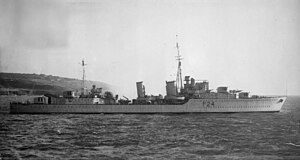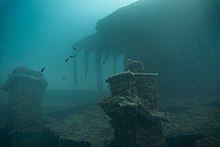HMS Maori (F24)
 HMS Maori underway
| |
| History | |
|---|---|
| Name | HMS Maori |
| Namesake | Māori people |
| Ordered | 10 March 1936 |
| Builder | Fairfield Shipbuilding and Engineering Company, Govan |
| Cost | £340,622 |
| Laid down | 6 July 1936 |
| Launched | 2 September 1937 |
| Completed | 30 November 1938 |
| Commissioned | 2 January 1939 |
| Identification | pennant number L24/F24/G24 |
| Fate | Sunk, 12 February 1942 |
| General characteristics (as built) | |
| Class and type | Template:Sclass2- |
| Displacement | |
| Length | 377 ft (115 m) (o/a) |
| Beam | 36 ft 6 in (11.13 m) |
| Draught | 11 ft 3 in (3.43 m) |
| Installed power |
|
| Propulsion | 2 × shafts; 2 × geared steam turbines |
| Speed | 36 knots (67 km/h; 41 mph) |
| Range | 5,700 nmi (10,600 km; 6,600 mi) at 15 knots (28 km/h; 17 mph) |
| Complement | 190 |
| Sensors and processing systems | ASDIC |
| Armament |
|
HMS Maori was a Template:Sclass2- destroyer named after the indigenous Māori people of New Zealand. She served with the United Kingdom Mediterranean Fleet during World War 2 until she was bombed and sunk by German aircraft while at Malta in 1942. Her wreck was later raised and scuttled outside the Grand Harbour. The wreck is now a dive site.
Description
The Tribals were intended to counter the large destroyers being built abroad and to lend gun support to the existing destroyer flotillas and were thus significantly larger and more heavily armed than the preceding Template:Sclass2-.[1] The ships displaced 1,891 long tons (1,921 t) at standard load and 2,519 long tons (2,559 t) at deep load.[2] They had an overall length of 377 feet (114.9 m), a beam of 36 feet 6 inches (11.1 m)[3] and a draught of 11 feet 3 inches (3.4 m).[4] The destroyers were powered by two Parsons geared steam turbines, each driving one propeller shaft, using steam provided by three Admiralty three-drum boilers. The turbines developed a total of 44,000 shaft horsepower (33,000 kW) and gave a maximum speed of 36 knots (67 km/h; 41 mph).[3] The ships carried enough fuel oil to give them a range of 5,700 nautical miles (10,600 km; 6,600 mi) at 15 knots (28 km/h; 17 mph).[4] The ships' complement consisted of 190 officers and ratings, although the flotilla leaders carried an extra 20 officers and men for the Captain (D) and his staff.[5]
The primary armament of the Tribal-class destroyers was eight quick-firing (QF) 4.7-inch (120 mm) Mark XII guns in four twin-gun mounts, designated 'A', 'B', 'X', and 'Y' from front to rear. For anti-aircraft (AA) defence, they carried a single quadruple mount for the 40-millimetre (1.6 in) QF two-pounder Mk II "pom-pom" AA gun and two quadruple mounts for the 0.5-inch (12.7 mm) Mark III machine gun.[6] The ships were fitted with a single above-water quadruple mount for 21-inch (533 mm) torpedoes.[5] The Tribals were not intended as anti-submarine ships, but they were provided with ASDIC, one depth charge rack and two throwers for self-defence, although the throwers were not mounted in all ships;[7] Twenty depth charges were the peacetime allotment, but this increased to 30 during wartime.[8]
Wartime modifications
Heavy losses to German air attack during the Norwegian Campaign demonstrated the ineffectiveness of the Tribals' anti-aircraft suite and the RN decided in May 1940 to replace 'X' mount with two QF 4-inch (102 mm) Mark XVI dual-purpose guns in a twin-gun mount. To better control the guns, the existing rangefinder/director was modified to accept a Type 285 gunnery radar as they became available. The number of depth charges was increased to 46 early in the war, and still more were added later.[9] To increase the firing arcs of the AA guns, the rear funnel was shortened and the mainmast was reduced to a short pole mast.[10]
Construction and career
Maori was laid down by the Fairfield Shipbuilding and Engineering Company at Govan in Scotland on 6 June 1936 and launched on 2 September 1937 by Mrs. W. J. Jordan, the wife of the New Zealand High Commissioner Bill Jordan.[11] The ship was commissioned on 2 January 1939.
Maori joined HMS Cossack's division in January 1939 and joined the Mediterranean Fleet. She and the other Tribal-class destroyers did convoy escort duties, and Maori then returned to Britain in October. Until April 1940 she patrolled the North Sea and also took part in the Norwegian Campaign. In June she sailed to Iceland looking for German warships and also served briefly in the Faroe Islands.[12]
In May 1941, she participated in the pursuit and destruction of the German battleship Bismarck. While escorting Convoy WS-8B to the Middle East, Maori, along with the destroyers Cossack, Sikh and Zulu broke off on 26 May and headed towards the area where Bismarck had been reported. They found her that evening and made several torpedo attacks in the evening and into the next morning. No hits were scored but they kept her gunners from getting any sleep, making it easier for the battleships to attack her the next morning. Maori then rescued some of the survivors from Bismarck after the battleship sank.[13]
She served with the 14th Destroyer Flotilla during the Battle of Cape Bon in December 1941.[14] Maori, commanded by Commander R. E. Courage, RN, was attacked by German aircraft and sunk at her moorings in the Malta Grand Harbour on 12 February 1942, with the loss of one of her crew; she was raised and scuttled off Fort Saint Elmo on 15 July 1945.
Wreck


Located a few hundred metres from the shore from Valletta, HMS Maori is now a popular dive site. The bow section lies in white sand at a depth of 14 m (46 ft), the aft section of the ship having been abandoned in deep water during the tow from Grand Harbour to Marsamxett Harbour. Much of the forward superstructure is extant, including the two front gun bases. Much marine life can be found on the wreck.
Notes
- ^ Lenton, p. 164
- ^ English, p. 14
- ^ a b Lenton, p. 165
- ^ a b English, p. 12
- ^ a b Whitley, p. 99
- ^ Hodges, pp. 13–25
- ^ Hodges, pp. 30–31, 40
- ^ English, p. 15
- ^ Friedman, p. 34; Hodges, pp. 41–42
- ^ Whitley, p. 116
- ^ The Times (London), 3 September 1937, p. 6
- ^ "HMS Maori". Subway Dive Centre. Archived from the original on 11 October 2014. Retrieved 2 September 2014.
- ^ The Times (London), 28 May 1941, p. 4
- ^ The Times (London), 15 December 1941, p. 3
References
- Brice, Martin H. (1971). The Tribals. London: Ian Allan. ISBN 0-7110-0245-2.
- English, John (2001). Afridi to Nizam: British Fleet Destroyers 1937–43. Gravesend, Kent: World Ship Society. ISBN 0-905617-64-9.
- Friedman, Norman (2006). British Destroyers and Frigates, the Second World War and After. Annapolis, Maryland: Naval Institute Press. ISBN 1-86176-137-6.
- Haarr, Geirr H. (2010). The Battle for Norway: April–June 1940. Annapolis, Maryland: Naval Institute Press. ISBN 978-1-59114-051-1.
- Haarr, Geirr H. (2009). The German Invasion of Norway, April 1940. Annapolis, Maryland: Naval Institute Press. ISBN 978-1-59114-310-9.
- Hodges, Peter (1971). Tribal Class Destroyers. London: Almark. ISBN 0-85524-047-4.
- Lenton, H. T. (1998). British & Empire Warships of the Second World War. Annapolis, Maryland: Naval Institute Press. ISBN 1-55750-048-7.
- Rohwer, Jürgen (2005). Chronology of the War at Sea 1939–1945: The Naval History of World War Two (Third Revised ed.). Annapolis, Maryland: Naval Institute Press. ISBN 1-59114-119-2.
- Whitley, M. J. (1988). Destroyers of World War Two: An International Encyclopedia. Annapolis, Maryland: Naval Institute Press. ISBN 0-87021-326-1.
External links
- 1937 ships
- Tribal-class destroyers (1936) of the Royal Navy
- Ships built in Govan
- World War II destroyers of the United Kingdom
- Destroyers sunk by aircraft
- World War II shipwrecks in the Mediterranean
- Wreck diving sites
- Maritime incidents in February 1942
- Shipwrecks of Malta
- Underwater diving sites in Malta
- History of Valletta
- Maritime incidents in July 1945
- Ships sunk by German aircraft
